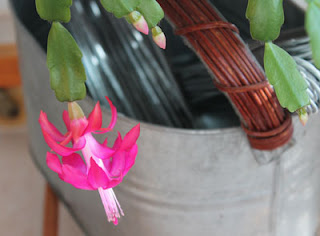Plan for insects. This winter, as you dream and plan for next year's garden, think of plants that insects will like. Introduce into your garden as many native plants as you can to ensure that the insects are fed.
Don't want insects in your garden? Think on this: most baby birds depend on insects for their growth. If parent birds can't find enough insects, the babies are weaker and may not survive. And we depend on insects to clean up the rubbish of the world and to pollinate our plants for next year's growth and this year's food.
And, of course, bees (my favourite insects) pollinate plants to make sure fruit and seeds are produced.
Expect insect bites on your plants. When you see bites, you know the system is working. The more bites, the healthier your garden is. Encourage insects to your garden by providing habitat for them. Here's one of my favourite pages for insect habitat:
Monday, December 31, 2012
Sunday, December 30, 2012
Christmas Cactus
Christmas is almost
here when the buds swell on the Christmas Cactus.
My Christmas Cactus is
an older variety with stem segments (phylloclades)
that undulate gracefully instead of
ending in little points along the edge and is probably Schlumbergera x buckleyi.
The Christmas Cactus I
have now is not the original one I inherited in 1976 but a cutting of a cutting of a cutting.
Once every two or three years, I take cuttings, choose the best of the rooted
cuttings, and discard the mother plant in favour of a smaller one with a less
sprawling spread, a new plant that fits in the spot allocated to it.
My
cactus actually blooms at Christmas unlike many store-bought cacti that should
more accurately be called Holiday Cacti since their natural bloom time may be Thanksgiving
or Easter, instead of Christmas. Those cacti
with the flowering blooms we purchase in Fall/Winter have been forced to
bloom. Their natural bloom time won’t be
obvious until they have grown for a full cycle.
I keep
my Christmas Cactus in our back sunroom, lit by natural light only, cooled in
summer by open windows and barely warmed in winter by one hot air outlet travelling
under the room across an unheated, dirt-floored crawl space, losing much of its
heat before it enters the room. The room gets quite cold but never freezes.
My plant
sits in eastern light that is also perfect for African violets and is exposed
only to available light and the temperature changes that follow the season by
diminishing as Christmas nears. Bud set, beginning somewhere around the first
of November, is spurred into action by those seasonal changes, a lessening of
available light or a reduction of temperature or maybe both.
Christmas
cacti are very sensitive once they begin to set bloom and should never, never
be moved once bloom set has begun. Changes to light or temperature will cause
new buds to drop.
At one
time I used to transfer the current Christmas Cactus to a shady spot outside –
a holiday for the plant. One year I
almost lost it when I forgot about it and left it outside until after the first
bad frost. When the plant was brought
in, all the stem segments shriveled and died but the main plant was OK and
eventually put out new stems. There was
no bloom that year but the plant lived to bloom again the next year. Since that almost death of the plant my
memory has not improved so the plant resides inside all year.
After so
many years of predictable show, my Christmas Cactus is an old friend giving me
the feeling that all’s right with the world when the Christmas Cactus blooms.
Sunday, December 23, 2012
Typha in Winter
Winter is here and it is beautiful. I don't cut plants down in the fall and am able to enjoy their forms when the snow comes.
This dwarf bulrush grows at the side of our pond. You hardly notice it in the summer but it is a wonderful sight after the snow falls. It will stay that way most of the winter, feeding small birds and enhancing the garden.
Until they soften and fall, the remnants of our plants feed the birds. Then they feed the soil. It's the way it was meant to be.
A friend once commented: "Your garden isn't your livingroom. Leave it messy." She didn't see my livingroom!
This dwarf bulrush grows at the side of our pond. You hardly notice it in the summer but it is a wonderful sight after the snow falls. It will stay that way most of the winter, feeding small birds and enhancing the garden.
Until they soften and fall, the remnants of our plants feed the birds. Then they feed the soil. It's the way it was meant to be.
A friend once commented: "Your garden isn't your livingroom. Leave it messy." She didn't see my livingroom!
Subscribe to:
Comments (Atom)


